A sports hernia [1] (also known as athletic pubalgia or sportsman’s hernia) is an injury involving the sift tissue in the lower abdomen or groin. unlike the traditional hernia, it does not always create a visible bulge.
Still, it can caused significant groin pain that worsens during sports activities involving sudden movements, twisting, sprinting, or repetitive kicking, such as in soccer or ice hockey.
A sports hernia occurs when the muscles and tendons in the lower abdomen, pelvic region [2], or hip area become strained, overstretched, or torn due to repetitive stressor intense physical activity.
The injury often involves strain around the pubic bone, groin area, and abdominal wall. This leads to chronic groin pain or ongoing pain that makes it difficult to return to full physical activity.
A physical examination, along with imaging tests such as magnetic resonance imaging (MRI), helps a healthcare provider or physical therapist confirm the diagnosis of a sports hernia. To further assess the condition, your doctor may ask you to perform a sit-up or flex your trunk against resistance.
Here are effective sports hernia rehab exercises:
1. Butterfly Stretch

- Begin in an upright sitting position on the floor, maintaining good alignment with your head, shoukders, and hips.
- Engage your core and bring the soles of your feet together, spreading your knees out to the sides while keeping your spine straight.
- Hold the position for several deep belly breaths, in through your nose and out through your mouth.
- Flap your knees up and down like butterfly wings to make this exercise challenging.
2. Kneeling Hip Flexor Stretch
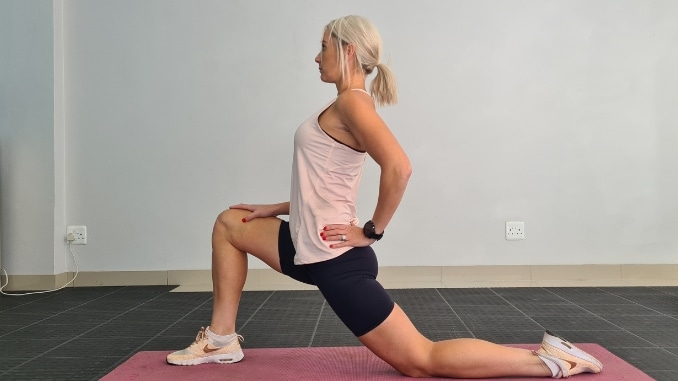
- Begin in an upright kneeling position, step one foot forward and bend the knee.
- Keep the back knee directly under the hip, then shift your weight forward until you feel a stretch along the front of the hip.
- Hold the position for several deep belly breaths, in through your nose and out through your mouth.
- Repeat the movement on the opposite side.
3. Standing Quad Stretch

- Begin in an upright standing position in front of a chair with your feet hip-width apart.
- Maintain good alignment from your head, shoulders, hips and legs.
- Place your hand on the chair for support. Engage your core muscles.
- Bring one heel up against your buttocks, holding your foot with your opposite hand.
- Gently pill the foot towards your glutes, feeling a light stretch in front of your thighs.
- Hold the position for several deep belly breaths, in through your nose and out through your mouth.
- Relax and repeat the movement on the opposite side.
4. Hamstring Stretch
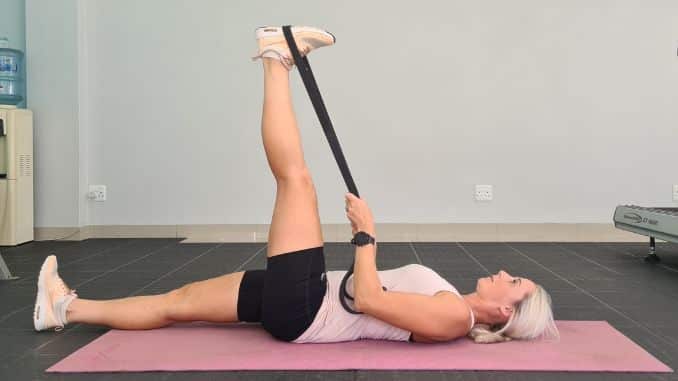
Hamstring tension can significantly contribute to groin pain due to its impact on the pelvis. Grab a stretch strap, towel, or belt to get started with this stretch.
- To start your sports hernia rehab exercises, lie on your back and wrap your stretching strap around the mid-foot of the leg you want to stretch.
- Then, with a straight knee, bring your entire leg up toward your chest.
- Continue pulling until you feel a stretch in the back of the thigh, and hold.
- Focus on staying relaxed and hold for 30 seconds for 2-3 sets on each leg.
5. Banded Hip Flexion
Use resistance bands to activate and lengthen the hip flexor while maintaining a neutral spine.
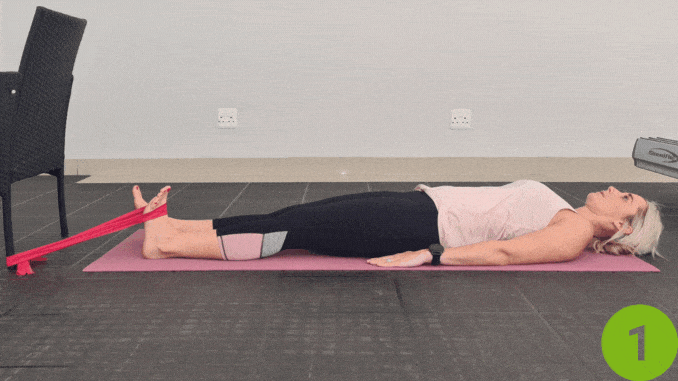
- Attach a resistance band to a fixed object, lie down on the ground, and wrap it around your left foot.
- Then, position yourself so there’s tension in the band.
- With your core tight and feet dorsiflexed, bend your left knee and hip until both joints are at a 90-degree angle.
- Slowly straighten your leg to return to the starting position.
- Perform this for 5 repetitions per leg.
Strengthening (Core Stability & Recovery)
6. Glute Bridge Leg Lifts

- Lie on your back on the floor with one leg extended and the other leg bent.
- Maintain good alignment with your upper body.
- Place your hands at your side, palms pressed on the floor.
- Engage your core muscles.
- Then push from your heels to lift your hips and extend one leg up, squeezing your glutes.
- Hold the position for several deep belly breaths, in through your nose and out through your mouth.
- Relax and repeat the movement on the opposite side.
7. Double Leg Toe Taps

- Lie on your back with your abs tight.
- Bring both knees up toward the sky while keeping your back relatively flat—a slight arch is okay for the lumbar spine, but nothing more.
- Then, slowly bring both your feet back down to touch the floor.
- Your back should stay stable and flat against the floor with minimal wobbling.
- Repeat for 10-15 repetitions for 2-3 sets.
- If this move is too hard, simply modify it to one leg at a time.
8. Clam Shells
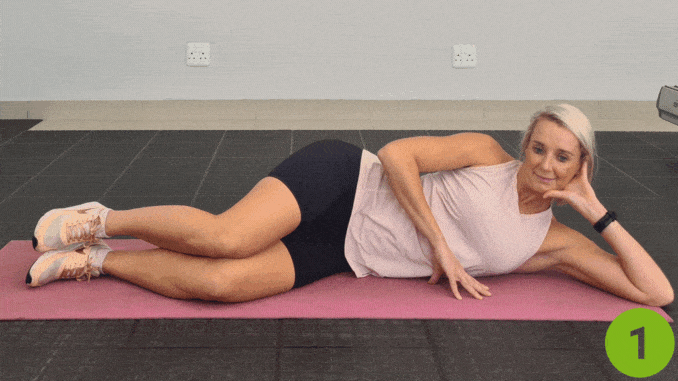
- Lie on your side, with the hip you want to work with facing up.
- Make sure the hips, legs, shoulders, and feet are all stacked directly on top of each other.
- Have the knees and hips bent about 45-degree so that the knees are in front of the body and the feet are in line with the rest of the body.
- Engage your core, and gently lift the top knee toward the ceiling while keeping your feet pressed together.
- Make sure your hips remain stacked and your pelvis doesn’t roll backward.
- Hold for 1-2 seconds before returning to the starting position.
- Repeat for 5-10 repetitions per leg.
9. Bird Dog
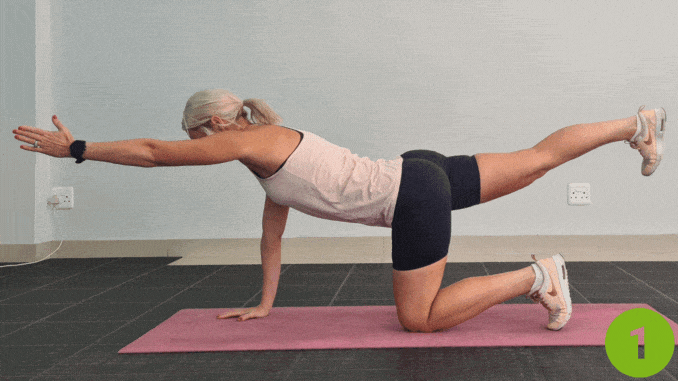
- Start by getting on all fours with your hands directly under your shoulders.
- Push your hands “down” into the ground to activate the shoulders and keep them from sagging.
- Keep the abs tight and the back relatively flat.
- Then, lift one arm and the opposite leg at the same time- extending them both as far as possible (arm Forward and leg extended backward).
- Perform this for 10 repetitions on each side.
10. Plank
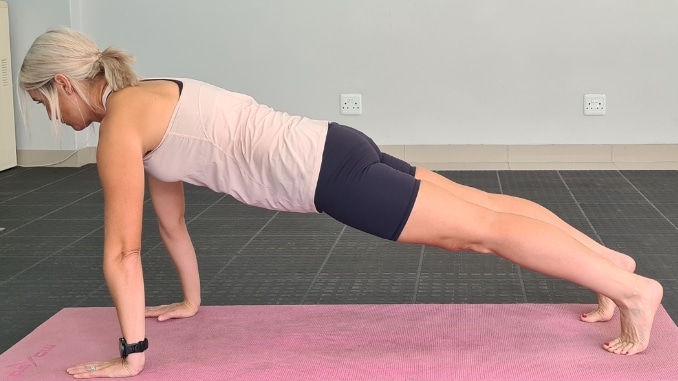
- Begin in a straight arm plank position with your legs straight and your arms beneath your shoulders.
- Hold the position for several deep breaths, in through your nose and out through your mouth.
- You can do this for 30 seconds to 1 minute.
Rehab Exercises for Sports Hernia
Sports hernia rehabilitation typically begins with early rehab exercises that reduce strain, followed by core exercises and strengthening exercises to build stability. A treatment plan should be tailored by a healthcare professional, often starting with conservative treatments, such as rest, ice, and anti-inflammatory medications, should be started within 1-3 days following the injury.
Early rehabilitation exercises may be initiated after 3 days, or once the pain is manageable.
These exercises offer safe progressions, transitioning from gentle stretches to more advanced exercises that help restore core stability and prevent future injuries.
Dr. Michael Fredericson, a prominent American physician and sports-medicine specialist at Stanford, emphasizes that core stability and muscle balance are essential in both preventing and rehabilitating groin injuries, like sports hernias. He argues that:
“Many lower-abdominal and groin problems arise not from one acute “tear” alone, but from weak or under-coordinated core muscles, hip muscles, and abdominal muscles failing to absorb torque during sports.”
His work suggests that effective sports hernia rehabilitation requires targeting both the abdominal wall and surrounding pelvic/hip stabilizers to restore core strength, reduce chronic pain, and help athletes return to high-performance levels.
Proven Treatments for Sports Hernia
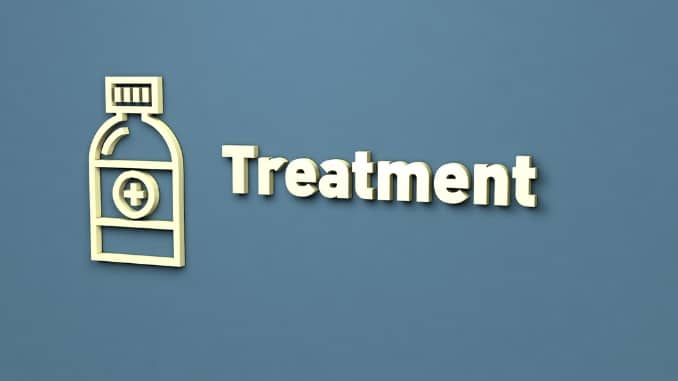
While sports hernia exercises are a cornerstone of recovery, a full treatment plan often includes multiple approaches:
- Conservative Treatment: Rest, ice, manual therapy, pain modalities, and physical therapy targeting the hips, core muscles and groin area.
- Non-Surgical Treatment: A structured exercise program guided by a physical therapist, using medicine balls, resistance balls, resistance bands, and gradual exercise progressions until the athlete reaches pre-injury levels.
- Surgical Treatment: For severe or ongoing pain, surgical intervention may be necessary. Options include laparoscopic surgical procedures or an open surgical procedure to repair the soft tissue damage. After surgery, a guided rehabilitation program helps ensure that sports hernias heal correctly and reduces the risk of future injuries.
Returning to full physical activity depends on the severity of the injury, adherence to the treatment plan, and whether surgical treatment was required. With proper care, many athletes can resume play with decreased pain and improved core strength.
Key Takeaway
Recovering from a sports hernia requires a balanced approach of stretching, strengthening exercises, and, when needed, surgical rehabilitation [3]. With the right rehab exercises, guided by a healthcare professional, athletes can reduce chronic pain, rebuild core stability, and return safely to their sports activities.
Strengthening your core is the key to better balance, improved mobility, increased strength, more flexibility… and avoiding loss of independence. Check out our 10 Easy Movements For A Stronger Core now!
FAQs
How long does recovery take with rehab exercises?
Most people improve within 6-8 weeks, though full return to sport may take 8-12 weeks or longer, depending on severity.
Can sports hernias heal with just rest and exercise?
In some cases, yes. However, many cases require structured physical therapy, and sever or persistent injuries may necessitate surgery.
Are there risks of re-injury during rehab exercises?
Yes, if you push too fast or skip progressions. Always start with gentle stretches, progress gradually, and follow your physical therapist’s plan.


